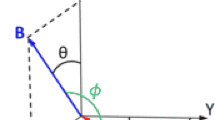Abstract
A special regime of the lower ionosphere sounding at altitudes of about 100 km reveals radio reflections from fairly dense (with a line density of 1014–1016 m–1) ionized meteor trails with a characteristic lifetime from a few tens of seconds to several tens of minutes. During the first 250 s, radio reflections from ionized trails with a line density of (2–3) × 1015 m–1 exhibit a power-law time dependence of the frequency of the reflected radio signal, \(f \propto {{t}^{{ - \gamma }}}\), with γ = 0.5 (classical diffusion mode). Less dense trails decay more slowly (γ < 0.5, subdiffusion mode), while denser ones decay faster (γ > 0.5, superdiffusion mode). It is shown that different modes of diffuse spreading of meteor trails can be caused by the high inhomogeneity of the medium and depend on the scale of ionized trails arising upon destruction of meteoroids.


Similar content being viewed by others
REFERENCES
V. A. Bronshten, Physics of Meteor Phenomena (Nauka, Moscow, 1981) [in Russian].
P. F. Goldsbrough and C. D. Ellyett, J. Geophys. Res. 81, 6135 (1976).
T. Maruyama, H. Kato, and M. Nakamura, J. Geophys. Res. 108, 1324 (2003).
A. Kozlovsky, S. Shalimov, J. Kero, T. Raita, and M. Lester, J. Geophys. Res. 123, 5974 (2018).
E. A. Silber, W. K. Hocking, M. L. Niculescu, M. Gritsevich, and R. E. Silber, Monthly Not. Royal Astronom. Soc. 469, 1869 (2017).
S. L. Shalimov and A. E. Kozlovskii, Plasma Phys. Rep. 41, 645 (2015).
A. M. Dykhne, I. L. Dranikov, P. S. Kondratenko, and A. V. Popov, J. Hydraulic Res. 43, 213 (2005).
J. L. Chau, I. Strelnikova, C. Schult, M. M. Oppenheim, M. C. Kelley, G. Stober, and W. Singer, Geophys. Rev. Lett. 41, 3336 (2014).
L. D. Landau and E. M. Lifshitz, Fluid Mechanics (Nauka, Moscow, 1986; Pergamon, Oxford, 1987).
F. J. Lubken, J. Geophys. Res. 97, 20385 (1992).
M. C. Kelley, C. A. Kruschwitz, C. S. Gardner, J. D. Drummond, and T. J. Kane, J. Geophys. Res. 108, 8454 (2003).
L. F. Richardson, Proc. Royal Soc. London A 110, 709 (1926).
A. N. Kolmogorov, Dokl. Akad. Nauk SSSR 30, 299 (1941).
A. M. Obukhov, Izv. AN SSSR, Ser. Geograf. Geofiz. 5, 453 (1941).
G. Batchelor, Quarterly J. Royal Meteorol. Soc. 76, 133 (1950).
J. P. Younger, C. S. Lee, I. M. Reid, R. A. Vincent, Y. H. Kim, and D. J. Murphy, J. Geophys. Res. Atmos. 119, 10027 (2014).
Author information
Authors and Affiliations
Corresponding author
Additional information
Translated by E. Chernokozhin
Rights and permissions
About this article
Cite this article
Shalimov, S.L., Kozlovskii, A.E. On the Modes of Diffuse Spreading of Ionized Meteor Trails. Plasma Phys. Rep. 45, 936–940 (2019). https://doi.org/10.1134/S1063780X1909006X
Received:
Revised:
Accepted:
Published:
Issue Date:
DOI: https://doi.org/10.1134/S1063780X1909006X




